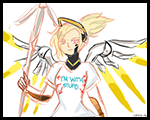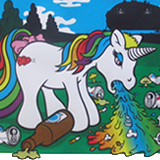|
oystertoadfish posted:i guess once you train the population of south melbourne to take that jughandle the whole thing will mean 'more go time'. until then, should be fun
|
|
|
|

|
| # ? May 28, 2024 07:06 |
|
FISHMANPET posted:Is there a reason streets are designed with high points in the middle to channel drainage to gutters on either side of the road, vs a low point in the middle with drainage happening in the middle of the street? On an unkerbed road, side ditches can just direct the water to the next low point without excessive pipes under the road. On a kerbed road, then it's safer to have the water pool at the sides not the center if the drain is blocked.
|
|
|
|
FISHMANPET posted:Is there a reason streets are designed with high points in the middle to channel drainage to gutters on either side of the road, vs a low point in the middle with drainage happening in the middle of the street? When you superelevate the roadway at curves (pretty much every curve needs superelevation unless you're super low-speed local/urban road), the roadway cross-slope will be a straight line from left to right or right to left. So every time your roadway turned, your drainage would have to shift from the middle of the road to the outside - not the end of the world, but another complication. Curb and gutter, used at the outside of closed-section roads, also has a little "extra"-steep cross slope that makes the road cross-slope steeper for 1 or 1.5 feet at the edge - which really helps keep the water from small rain storms from spreading out across the lanes. You wouldn't really be able to create local depressions in the center of the roadway like you can at the outside. You also have the problem of creating a giant puddle you'd turn across in the center of the roadway for everyone making left turns - rather than two smaller puddles at the outside edges. The big central puddle would also cover the double-yellow line, making it much less visible during rain events. Off-site drainage going to the roadway (say, from people's front yards) would have to cross all the travel lanes to reach the drainage channel in the center of the road, rather than being captured at the outside edge of the road. This would create more unsafe hydroplaning opportunities. Using center-of-road inlets would mean that all your inlets would have to be grate-style inlets, which are generally less efficient (requiring more inlets since each inlet can capture less flow) compared to COG inlets (the normal open-throat style you typically see). Grates are also more prone to clogging, so you'd have more maintenance requirements for your system. Additionally, putting all your drainage structures in the middle of the road will make that extra maintenance harder to do - you have to pop the inlet open, stick a vacuum hose / climb down to clear debris every year or two. If you're working in the center of the roadway, you'd have to close the two center lanes to establish a safe work zone. For curb inlets, you typically just park the vacuum truck in the outside lane, so it's possible to maintain at least one lane with a flagger. Interesting thought exercise.
|
|
|
|
FISHMANPET posted:Is there a reason streets are designed with high points in the middle to channel drainage to gutters on either side of the road, vs a low point in the middle with drainage happening in the middle of the street? you don't want water freezing in the middle of the road
|
|
|
|
Peanut President posted:you don't want water freezing in the middle of the road Also, when you have a lot of rain you don't want a big puddle forming in the middle of the road. With a crown the water will drain off to the sides where there's more capacity to absorb it.
|
|
|
|
So the reason I ask. Minneapolis is (hopefully) coming out of one of the most brutal winters we've ever seen, both in terms of temperature and volume of snow. Nearly every street gutter in the city is filled with ice that extends 2 feet out from the curb, except that many corners have been cleared to the pavement. We got 3 days of above freezing temperatures earlier this week along with rain, so we had a ton of water and melting snow. The storm drains are all buried under that mound of ice extending from the gutter. A lot of us have been chipping out storm drains to get some drainage going, which is great for the overall street, but all the corner crosswalks are now the lowest point in the drainage system, so they're full of water that's dammed in by nice on all sides. Even in cases where storm drains are near the corner, the're still 6-10 feet away which is an insurmountable amount of ice to clear away. It's basically not possible to drain our crosswalks without a jackhammer to break up ice, it's too thick and dense to be done by hand. And now we've got a couple of days where with sunlight in the day snow will melt, but at night it gets below freezing so all these puddles, pools, and lakes start to freeze. So I'm wondering if there's a better drainage scheme, and draining in the center was my first idea. I understand all the reasons for side draining, but it's not working for us right now with winter. It seems like with climate change it's less likely that we're slightly warmer, and more likely that we get more extreme weather on both ends of the spectrum, so we're likely to have big cold winter storms dumping tons of snow in addition to above freezing days where we get a lot of melt, followed by another freeze. So we need a drainage system that works even in our winter, and one that can quickly drain water before it has a chance to freeze again.
|
|
|
|
Plano tried doing an intersection like that and since soooooo many entitled people live in that area, they could not fathom the idea of not doing what they used to and/or what they wanted. Eventually they just reverted it to a normal intersection.
|
|
|
|
|
FISHMANPET posted:So the reason I ask. Minneapolis is (hopefully) coming out of one of the most brutal winters we've ever seen, both in terms of temperature and volume of snow. Nearly every street gutter in the city is filled with ice that extends 2 feet out from the curb, except that many corners have been cleared to the pavement. We got 3 days of above freezing temperatures earlier this week along with rain, so we had a ton of water and melting snow. The storm drains are all buried under that mound of ice extending from the gutter. A lot of us have been chipping out storm drains to get some drainage going, which is great for the overall street, but all the corner crosswalks are now the lowest point in the drainage system, so they're full of water that's dammed in by nice on all sides. Even in cases where storm drains are near the corner, the're still 6-10 feet away which is an insurmountable amount of ice to clear away. It's basically not possible to drain our crosswalks without a jackhammer to break up ice, it's too thick and dense to be done by hand. And now we've got a couple of days where with sunlight in the day snow will melt, but at night it gets below freezing so all these puddles, pools, and lakes start to freeze. If the central leg of each intersection is submerged you still have to get your feet wet unless you're doing a lap of your block without crossing the street I was going to suggest a system of tunnels and skyways like Minneapolis but you're already in Minneapolis! The solution is to expand those networks. Or waste Megawatts of energy to pipe steam around and keep the pavement above freezing.
|
|
|
|
Most intersections are some variations on this: https://twitter.com/fishmanpet/status/1105976430683410433 The streets are clear of snow because of plowing and the relentless pounding of car tires, and the crosswalks are clear because people keep them shoveled, but the path to the drain is blocked by the ice in the gutter. My thought is that if the drain was in the center of the street, which is generally much clearer than the gutter, that water would run their and drain away. Relatedly, I'm currently researching if I can use something like a battery operated hammer drill to break up ice
|
|
|
|
FISHMANPET posted:Most intersections are some variations on this: https://twitter.com/fishmanpet/status/1105976430683410433 The center is clearer than the gutter because it's the high point, water drains away from it If we put the low point at the center, the water will make its way there and freeze Snow plows work because they push the snow out of the important part of the roadway where the driving happens - and then gravity takes the melting water away from the important part of the roadway where the driving happens. If you put the low spot at the center, but keep pushing the snow to the curbs, then the snow melt will run across the roadway and re-freeze completely covering the road with a sheet of ice.
|
|
|
|
you need bigger drains put these where the crosswalk meats sidewalk, bonus: no more cows in the crosswalk
|
|
|
|
Devor posted:The center is clearer than the gutter because it's the high point, water drains away from it The ice that's there isn't there because it was liquid water that froze, it was snow that got compacted so much that it froze into ice.
|
|
|
|
FISHMANPET posted:So the reason I ask. Minneapolis is (hopefully) coming out of one of the most brutal winters we've ever seen, both in terms of temperature and volume of snow. Nearly every street gutter in the city is filled with ice that extends 2 feet out from the curb, except that many corners have been cleared to the pavement. We got 3 days of above freezing temperatures earlier this week along with rain, so we had a ton of water and melting snow. The storm drains are all buried under that mound of ice extending from the gutter. A lot of us have been chipping out storm drains to get some drainage going, which is great for the overall street, but all the corner crosswalks are now the lowest point in the drainage system, so they're full of water that's dammed in by nice on all sides. Even in cases where storm drains are near the corner, the're still 6-10 feet away which is an insurmountable amount of ice to clear away. It's basically not possible to drain our crosswalks without a jackhammer to break up ice, it's too thick and dense to be done by hand. And now we've got a couple of days where with sunlight in the day snow will melt, but at night it gets below freezing so all these puddles, pools, and lakes start to freeze. Look at different drain types. Countries with regular heavy snowfall don't usually have the open type that leads sideways into the curb. Instead Scandinavian towns have these grates in the road surface. The plows pass over the grate, clearing it of snow with every pass. Hence, a well plowed street has no blocked drain. The snow melt on the side of the road can then flow down freely. I think the "side-draining" type is better at handling extreme rainfall, at least I've seen it most often in tropical countries. I don't know if Minneapolis has very heavy rainfall? Edit: Here's an example on a minor street but you don't usually need a much bigger grate than this. https://goo.gl/maps/GXVMqE2Vn7T2 I suppose the key is, your snow clearing needs to keep drains clear. It sounds kind of trivial when you spell it out, doesn't it? Hippie Hedgehog fucked around with this message at 23:51 on Mar 15, 2019 |
|
|
|
My observation is that it basically wasn't possible to keep the drains clear this season. I live on a corner, and there's no parking in front of my house on either side, so the streets were always clear to be plowed to the curb. But for whatever reason... they weren't. And other streets that don't get plowed until a day or two after snow stops (we have a system where a snow emergency is declared, many streets get plowed that night, and then side streets got plowed the next day or the day after). If it were a few small areas that weren't cleared to the curb I'd say we just need to do a better job. But considering the entire city, including the downtown core, wasn't cleared the the curb tells me that it just was not possible to do with this year's snow load.
|
|
|
|
The solution is to have drains near intersections, so it's easier to clear them in conditions like that.
|
|
|
|
Peanut President posted:Man I've driven that road a fair few times (family in Flora + driving to the Amtrak in Effingham) and I always wondered what those bridges were all about. Also 50 is a four lane highway between Lawrenceville and Vincennes before going back to 2 lanes right after it crosses the river. I never imagined I’d see my hometown mentioned in this thread. Those bridges are weird and I’m glad I know what happened now. I need to take some pictures of the weird poo poo they’ve done with I-69 between Bloomington and Martinsville as the most recent section done.
|
|
|
|
It took me a long time but I finally found a red diamond, lmao. It's along MA-125/Andover Bypass where a local connecting road was artificially ended due to a signaled intersection just slightly further up the road. Can't see the front of them on Google Maps because there's no streetview on that road, but they're there 
|
|
|
|
Goddammit, Boston. You got the basketball hoop right, yet you used the wrong OM signs. https://www.google.com/maps/@42.3441733,-71.1370135,3a,35.8y,39.3h,88.07t/data=!3m6!1e1!3m4!1s9eJb1DdgqIj1rG6H5-v8hQ!2e0!7i16384!8i8192 I tried to find one. I really tried. https://www.google.com/maps/@42.356...!7i16384!8i8192 Seriously, what the gently caress, Boston? https://www.google.com/maps/@42.3540129,-71.0482877,3a,50.1y,302.4h,87.21t/data=!3m6!1e1!3m4!1sKCvASPwClx7cC79dQTwgLA!2e0!7i13312!8i6656
|
|
|
|
Varance posted:Seriously, what the gently caress, Boston? Back in the day, the Barking Crab used to dump their people-poop right next to the crab-water intake.
|
|
|
|
Here's a recent example: The main road here used to be at the surface and narrower, it led to a traffic circle junction with another main road in the area shortly after. Now it's on a wide viaduct over the old junction, with ramps to/from it to handle the traffic movements. In the process this side street got truncated from where it intersected another side street shortly before it intersected with the main road.
|
|
|
|
FISHMANPET posted:Most intersections are some variations on this: https://twitter.com/fishmanpet/status/1105976430683410433
|
|
|
|
Another good example of how to fix a colossal disaster of an intersection courtesy of my hometown  Sure, the diagonal Greene St is no longer contiguous and Maps hasn't updated its roads layer, but the six-point clusterfuck is now reduced at a minimum to 3 three-way intersections, or 1 three-way and 1 four-way intersection if you want to be liberal with the placement of the curbing. The guy who lives right on the corner has elected to place bollards in his own driveway, presumably because for the first 12 months, he had lots of fuckers driving right through the driveway not realizing. The town's solution has been a certainly non-MUTCD compliant sign that points to the continuation of Greene St. My question here is, when a town/city elects to remove a roadway in a way that adds green space, does that tract of land remain owned by the town? Or does the guy in that house get some extra front lawn now that his property is no longer abutted by the slip road?
|
|
|
|
The land doesn't get added to his land unless he buys it, or the town explicitly gives it to him for free.
|
|
|
|
Which is kind of why Ellis Island has the borders it has.
|
|
|
|
Tiny Tubesteak Tom posted:My question here is, when a town/city elects to remove a roadway in a way that adds green space, does that tract of land remain owned by the town? Or does the guy in that house get some extra front lawn now that his property is no longer abutted by the slip road? Here's the old property lines from GIS (accurate enough for our chatting)  Obviously hasn't been updated for the new work. The property at 315 Mass Ave would have had to sell some property to do the intersection relocation. It's not 'typical' for an agency to convey a piece of property adjacent to an intersection like that. Maaaybe if it was an orphaned piece of property that became landlocked. But in this case that leftover piece might be useful for pedestrian facility, adding a turn lane, or whatever.
|
|
|
|
Does anyone know what these barriers are for? presumably to stop people doing sick jumps.
|
|
|
|
I would blow Dane Cook posted:Does anyone know what these barriers are for? presumably to stop people doing sick jumps. Looks like art to me. Way too many to accomplish the purpose of keeping vehicles out. Have a google maps link?
|
|
|
|
Modern tank traps, like the Siegfried line. Or does this border commonwealth land or something and is an artistic fence? Plenty of modern street furniture is now anti vehicle bollards and anchored well below ground. But a seat/solid bench if planter box is prettier than a row of bollards.
|
|
|
|
Devor posted:Looks like art to me. Way too many to accomplish the purpose of keeping vehicles out. Have a google maps link? I'd rather not sorry drunkill posted:Modern tank traps, like the Siegfried line. It does border military owned land, but the military isn't using it anymore.
|
|
|
|
In my state, a Republican state legislator introduced and the state congress passed a bill that would result in fines for anyone going under the non-specific "speed of traffic" in the left lane. While it superficially makes sense that we'd want to encourage use of the lane as a passing lane, the actual motive behind the bill is to further enshrine raw speed as the end-all be-all of our road systems. The number of times I've been "inconvenienced" by someone maintaining the speed limit or slightly under in the last five years is 0. The number of times I've witnessed wildly unsafe behavior from drivers intent on maximizing the speed at which they get to their destination in the last week is too many to count. Enforcement against the latter is minimal, in no small part because feeling entitled to speed is largely accepted as part of our car culture. Anyway, that brought me to this thread. I'd be curious where urban planners and urban planning aficionados fall on this in 2019. If the OP from 2009 is anything to go by, the answer might still be gently caress those slowpoke grandmas. The OP hasn't posted in three years, but appears to have some cognitive dissonance going on in which they recognize the significant harms of American car dependency and suburbia, yet prioritizes fast-flowing automobile traffic over all else. At least in my layman's understanding of current attitudes in the field, it's increasingly the consensus that doing this creates a feedback loop: prioritizing car traffic makes getting around on foot or bike more dangerous, resulting in fewer cyclists and pedestrians and more drivers on the road, further locking in place our extremely low density land use and putting parking lots everywhere. It's also disheartening to see a traffic engineer complain about "speed differentials" on a road signed for 25 in a way that puts blame on those arguing for and driving the limit, rather than those flagrantly violating it. Maybe the OP lives in the absolute boonies and is thinking of random rural roads through empty fields, but I see too many people who have the same mentality toward residential roads in my urban area. Higher speeds drastically increase the likelihood of pedestrian fatality and its wildly offensive to me that anyone involved with designing our roads would repeat that tired refrain.
|
|
|
|
What's the difference between a left turn with a yield on green light versus a flashing yellow arrow? Why would an engineer choose one over the other? In my area it is mostly flashing yellows and i hate them because i routinely find myself in the process of turning when they turn red because there isn't a clear distinction between "about to be red" yellow and "about to blink back off again" yellow.
|
|
|
|
Cugel the Clever posted:In my state, a Republican state legislator introduced and the state congress passed a bill that would result in fines for anyone going under the non-specific "speed of traffic" in the left lane. While it superficially makes sense that we'd want to encourage use of the lane as a passing lane, the actual motive behind the bill is to further enshrine raw speed as the end-all be-all of our road systems. The number of times I've been "inconvenienced" by someone maintaining the speed limit or slightly under in the last five years is 0. The number of times I've witnessed wildly unsafe behavior from drivers intent on maximizing the speed at which they get to their destination in the last week is too many to count. Enforcement against the latter is minimal, in no small part because feeling entitled to speed is largely accepted as part of our car culture. Not all of us are like that. I heartily support Vision 0 MPH
|
|
|
Cugel the Clever posted:speed I think the thing you're missing is that a lot of roads signed 25 mph are absolutely loving not 25 mph roads, and putting a sign next to them saying otherwise doesn't make it true. That law is a bad fix, though; the law we NEED would mandate that all speed limits are set by established science, not whatever arbitrary number the old people living nearby think everyone needs to do for their personal comfort.
|
|
|
|
|
Corla Plankun posted:What's the difference between a left turn with a yield on green light versus a flashing yellow arrow? Why would an engineer choose one over the other? In my area it is mostly flashing yellows and i hate them because i routinely find myself in the process of turning when they turn red because there isn't a clear distinction between "about to be red" yellow and "about to blink back off again" yellow. We don't use them here but my best guess would be that the flashing yellow inspires drivers to be more cautious when turning. They're probably a response to high crash rates at those intersections.
|
|
|
Javid posted:I think the thing you're missing is that a lot of roads signed 25 mph are absolutely loving not 25 mph roads, and putting a sign next to them saying otherwise doesn't make it true. Design roads to be 20/40/60, then laugh at the fatalities? The point of signing a road below potential max is that you get a safer road that handles the occasional rule breaking jackass which is preferred over scraping the rule breakers off the nearby side hazards. Maybe I’m misinterpreting you, but signing roads at or near their theoretical best case is a dubious idea.
|
|
|
|
|
Corla Plankun posted:What's the difference between a left turn with a yield on green light versus a flashing yellow arrow? Why would an engineer choose one over the other? In my area it is mostly flashing yellows and i hate them because i routinely find myself in the process of turning when they turn red because there isn't a clear distinction between "about to be red" yellow and "about to blink back off again" yellow. IMO, a flashing yellow arrow is a clear sign that you can turn but you have to yield. It's unambiguous and it has no other meaning. A solid green circle light with a "can make left turn but must yield" clause attached is more ambiguous and open to misinterpretation because the solid green circle ordinarily means that you have the right of way.
|
|
|
|
Anias posted:Design roads to be 20/40/60, then laugh at the fatalities? A road has a natural speed at which a large portion of drivers will drive, regardless of the posted speed limit, in absence of enforcement. This is generally (though not always) below the safe maximum for a given combination of road, vehicle, driver, and conditions. This is why many traffic engineering guidebooks recommend setting speed limits based on the normalized average speed of free flowing traffic. The 85th percentile speed is common, which means the speed limit should be high enough that 85% of free flowing traffic is legal. In other words, if you build a 45 MPH road and sign it 25, a lot of drivers are still going to go 45 unless they see cops/speed cameras/etc. If you want 25 MPH traffic you have to build a 25 MPH road. Setting the limit lower is just creating a speed trap for revenue enforcement to work. Narrowing lanes, chicanes, obstructions like street parking, islands, special markings, there are a lot of techniques for reducing the natural speed of a road. None of them involve arbitrarily changing numbers on a sign.
|
|
|
|
wolrah posted:A road has a natural speed at which a large portion of drivers will drive, regardless of the posted speed limit, in absence of enforcement. This is generally (though not always) below the safe maximum for a given combination of road, vehicle, driver, and conditions. This is why many traffic engineering guidebooks recommend setting speed limits based on the normalized average speed of free flowing traffic. The 85th percentile speed is common, which means the speed limit should be high enough that 85% of free flowing traffic is legal. Absolutely. Designing a road to be traveled at the speed that it is signed for will tend to improve safety overall, and there are a variety of ways of reducing the natural speed of a road without making those obstructions fatal.
|
|
|
|
More to the point, if you build a 45 road and sign it 25, you're now going to be seeing traffic from 20 to 55 on it. In this scenario, the people angrily going 25 when people want to pass and go 45 are in fact a danger to everyone around them, but it's the fault of whatever entity decided they knew better than established science, not the individual drivers. Compare this to just signing the same road at 45 like it should be, which is much safer.
|
|
|
|
|

|
| # ? May 28, 2024 07:06 |
|
Fun fact: it is in fact the people that do reckless things to get around drivers doing the posted limit who are the danger. I'm with you on how speed limits should be set, but ignoring the posted value because you think you know better is not the correct choice.
|
|
|











































 Yes, it's like a lava lamp.
Yes, it's like a lava lamp.